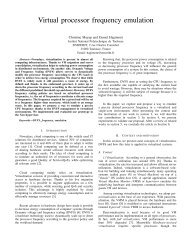SESSION NOVEL ALGORIHMS AND APPLICATIONS + ...
SESSION NOVEL ALGORIHMS AND APPLICATIONS + ...
SESSION NOVEL ALGORIHMS AND APPLICATIONS + ...
You also want an ePaper? Increase the reach of your titles
YUMPU automatically turns print PDFs into web optimized ePapers that Google loves.
42 Int'l Conf. Foundations of Computer Science | FCS'11 |<br />
Minimum Pseudo-Triangulation Using Convex Hull<br />
Layers<br />
F. Taherkhani 1 , A. Nourollah 1,2<br />
1 Department of Computer Engineering & IT, Islamic Azad University, Qazvin, Iran<br />
2 Department of Electrical & Computer Engineering, Shahid Rajaee Teacher Training University, Tehran, Iran<br />
Abstract - Pseudo-triangulation is regarded as one of the<br />
most commonly used problems in computational geometry. In<br />
this paper we consider the problem of minimum pseudotriangulation<br />
of a given set of points S in the plane using<br />
convex hull layers and we propose two new methods that will<br />
lead to the production of minimum pseudo-triangulation. This<br />
means that the number of pseudo-triangles created in<br />
minimum pseudo-triangulation is exactly n-2 pseudo-triangles<br />
and the minimum number of edges needed is 2n-3.<br />
Keywords: pseudo-triangulation, reflex chain, convex hull<br />
layers, visibility<br />
1 Introduction<br />
The names pseudo-triangle and pseudo-triangulation<br />
were coined by Pocchiola and Vegter in 1993. For polygons,<br />
pseudo-triangulations has been already expressed in the<br />
computational geometry’s literature in the early 1990’s, under<br />
the name of geodesic triangulations [1]. The geodesic path<br />
between two points of a polygon is the shortest path from one<br />
to the other in polygon. Pseudo-triangulations of a simple<br />
polygon are also called geodesic triangulations, because they<br />
arise by inserting non-crossing geodesic paths in polygon.<br />
A pseudo-triangle is a planar polygon with exactly three<br />
convex vertices, called corners and three reflex chains of<br />
edges join the corners. Let S be a set of n points in general<br />
position in the plane. A pseudo-triangulation for S is a<br />
partition of the convex hull of S into pseudo-triangles whose<br />
vertex set is S [2].<br />
In 2000, Streinu [3] has shown that there are strong links<br />
between minimally rigid graphs and minimum pseudotriangulations.<br />
In addition, she proved that the minimum<br />
number of edges needed to obtain a pseudo-triangulation is<br />
2n-3 and thus, by Euler's polyhedron theorem, the number of<br />
pseudo-triangles in a minimum pseudo-triangulation is n-2,<br />
which does not depend on the structure of the point set but<br />
only on its size [4]. Every vertex of a minimum pseudotriangulation<br />
is pointed. A vertex is pointed if it has an<br />
incident angle greater than .<br />
Pseudo-triangulations are received considerable attention in<br />
computational geometry. This is mainly due to their<br />
applications in rigidity theory, robot arm motion planning,<br />
visibility, ray-shooting, kinetic collision detection and<br />
guarding polygons [5-8].<br />
With respect to the fact that some of the interesting geometric<br />
and combinatorial properties of pseudo-triangulations have<br />
been recently discovered, but many main open questions still<br />
remain [2]. In this paper we consider the problem of minimum<br />
pseudo-triangulation of a set S of n points in the plane and we<br />
show that the generation of convex hull layers for set points<br />
and their pseudo-triangulation, using two new methods,<br />
minimizes pseudo-triangulation.<br />
The rest of this paper has been organized as follows: In<br />
section 2 some basic definitions are presented. Section 3<br />
describes how to create convex hull layers. In section 4<br />
determine for all vertices in convex hull layers visible<br />
vertices and finally in section 5 we propose two new methods<br />
of pseudo-triangulation on created convex hull layers to attain<br />
minimum pseudo-triangulation.<br />
2 Initial definitions<br />
A simple polygon is called a convex polygon when all the<br />
internal angles are less than . According to this definition,<br />
the set of points S on a plane is called convex if and only if in<br />
exchange for both the points p,q∈ S, the line segment pq<br />
completely lies inside S (pq ⊆ S).<br />
The most applicable structure in robatic geometry is convex<br />
hull. Convex hull of the given points p0,…, pn-1 is the smallest<br />
convex set on the plane which contains the points.<br />
Let three points p1(x1, y1), p2(x2, y2) and p3(x3, y3) are given in<br />
the plane. Hence matrix A is defined as follows:<br />
(1)









